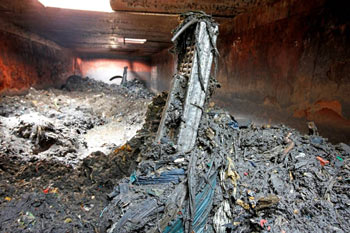Mechanical Biological Waste Treatment – Now Worth Another Look! Part II
September 21, 2022 by Glen Tobiason
MBT – Mechanical Biological Waste Treatment – Shunned in the Past – Now Worth Another Look! Part II
In Part I, we talked about the general positive aspects of such an MBT process. Now let’s look at how this process is designed and why.
You may ask why I inquire “why” above. The reason is that this MBT process is designed to fit the waste that is to be processed, not visa-versa. That means a municipality incorporating this process would not have to change its waste collection scheme to make it fit the process. The MBT process fits the waste stream! A distinct advantage here is the organics don’t have to be collected separately—they are part of the MSW stream. One less cart at home, one less truck out on the road collecting this pungent waste stream. It is economically and ecologically sound. Also, safer, as fewer personnel are out there collecting waste. Waste collection is sadly listed in the top 10 most dangerous jobs. In fact, in SWANA’s Strategic Plan 2023–2027 Forward Together, goal one is set as to “get off the top 10 list of most dangerous jobs.” This and other strategic subjects will be discussed at the “Town Hall Meeting” on October 11, 2022 from 2:00 pm – 3:00 pm Eastern time via Zoom. Your active participation would be welcome! Register here.
Regarding the MBT process, it has been shown that when a cooperation is set up between the municipalities with the waste, the waste collection entities, and the MBT plant, the whole waste process can be efficient, keeping the costs to the citizens low.
Now let’s dive into the five steps of this MBT process:
Step One – Material Acceptance: Here the waste in tipped onto the tipping floor by the local collection trucks including transfer vehicles. No private deliveries! Safety first! This building, as well all other buildings in all five steps, are under negative pressure. Outside air can enter but the pungent air on the inside can’t escape to the environment. A very positive environmental aspect!
The waste is sorted by personnel using a grabber on a vehicle or on a crane. Items such as large pieces, tires, rocks, white goods, etc. are separated out and brought later to a recycler, landfill, or incinerator, as appropriately. The desired waste is loaded by the grabber or crane onto an enclosed conveyor belt and brought over to step two. Enclosed conveyor belt systems are used throughout the plant (internally and externally) to reduce emissions to employees and to the environment. Again, safety first!
Step Two – Mechanical Preparation: Here the “good” waste from step one is conveyed into trommel sieves. These sieves sort by size only. Other MBT processes want to sort out the organics and do something with the rest but this defeats the purpose of a complete waste processing system. In step two, metals are sorted out via magnet and on manual sorting tables. Recyclables, inert materials, and other materials that would not be advantageous to the process down-stream are sorted out. Interesting point: personnel working the sorting tables do not have to wear dust or aspiration masks as their working environment is such that a conditioned, clean air is always surrounding them. Other PSE, such as safety shoes and puncture and cut protection gloves, must be always worn. Safety is a main concern at every step of the MBT process.
About 90 percent of the original amount of waste is conveyed after sorting in step two to step three.

Step Three – Biological Conversion: The “heart” of this MBT process. The waste from step two is conveyed to large horizontal mixing tanks called Multi Zone Reactors (MZR). The waste is mixed with processed water (not fresh water!). The waste is mixed – slowly – over two to maximum three days such that a very homogeneous slurry is obtained. Mixing this slurry requires strong and powerful agitators. The ones shown here in the picture have a torque of 1.2 Mio. NM, which is about 885,000 ft-lb!
After the time in the MZR the material is conveyed to a screw press. In the screw-press the liquids are separated form the solids. The liquids are brought to the fermenters where the high methane content (70–71 percent Methane) biogas is produced. The solid side left after the screw-press is conveyed to step four: Biological Drying.
But enough for today! A continued review of this process (step four - Biological Drying and step five - Mechanical Material Separation), its outputs, and their utilization can be found in upcoming additions to this blog thread. Stay tuned!

Glen Tobiason
InnoWaCon LLC
Innovative Waste Conversion technologies
President & CEO
734 East Penacook Road
Hopkinton, NH 03229-2911
Cell: +1 603 406 9883
E-Mail: glen.tobiason@innowacon.com
Bio: Glen Tobiason has received his Bachelors degree in Mechanical Engineering from Northeastern University, Boston. Glen has over thirteen years of in-depth experience with the Maximum Yield Technology (MYT®) of the ZAK. Being fluent in both English and German, he has introduced the benefits of MYT® to various countries and cultures. Glen has now founded the InnoWaCon LLC to market this and other waste conversion technologies in North America.







Leave a comment